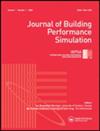经过验证的开源Modelica模型的直接蒸发冷却器与最小的输入
IF 2.3
4区 工程技术
Q2 CONSTRUCTION & BUILDING TECHNOLOGY
引用次数: 0
摘要
直接蒸发冷却器(DECs)是一种低能耗的冷却替代传统的空调在炎热干燥的气候。DEC的关键部件是冷却垫,它蒸发冷却通过它的空气。虽然已经为冷却垫提出了详细的传热传质数值模型,但这些模型需要许多不易获得的输入参数。另外,简化模型缺乏准确性,并且仅限于常见类型的冷却垫。为了解决这些限制,我们开发并验证了一个基于物理的模型,该模型只需要标称数据就可以相当准确地计算传热和传质。该模型是在基于方程的面向对象建模语言Modelica中实现的。为了进行比较,还实现了EnergyPlus基于冷却垫效率曲线的基本集总模型。基于物理的模型与实验数据的误差小于2%,集总模型的误差为12.3%。本文章由计算机程序翻译,如有差异,请以英文原文为准。
Validated open-source Modelica model of direct evaporative cooler with minimal inputs
Direct evaporative coolers (DECs) are a low-energy cooling alternative to conventional air conditioning in hot-dry climates. The key component of DEC is the cooling pad, which evaporatively cools the air passing through it. While detailed numerical models of heat and mass transfer have been proposed for the cooling pad, these require many input parameters that are not readily accessible. Alternatively, simplified models lack accuracy and are confined to common types of cooling pad. To address these limitations, we developed and validated a physics-based model, that only needs the nominal data to compute the heat and mass transfer with considerable accuracy. The proposed model is implemented in Modelica, an equation-based object-oriented modeling language. For comparison, a basic lumped model from EnergyPlus based on the efficiency curve of the cooling pad is also implemented. The physics-based model exhibits <2% error from the experimental data and the lumped model exhibits a 12.3% error.
求助全文
通过发布文献求助,成功后即可免费获取论文全文。
去求助
来源期刊

Journal of Building Performance Simulation
CONSTRUCTION & BUILDING TECHNOLOGY-
CiteScore
5.50
自引率
12.00%
发文量
55
审稿时长
12 months
期刊介绍:
The Journal of Building Performance Simulation (JBPS) aims to make a substantial and lasting contribution to the international building community by supporting our authors and the high-quality, original research they submit. The journal also offers a forum for original review papers and researched case studies
We welcome building performance simulation contributions that explore the following topics related to buildings and communities:
-Theoretical aspects related to modelling and simulating the physical processes (thermal, air flow, moisture, lighting, acoustics).
-Theoretical aspects related to modelling and simulating conventional and innovative energy conversion, storage, distribution, and control systems.
-Theoretical aspects related to occupants, weather data, and other boundary conditions.
-Methods and algorithms for optimizing the performance of buildings and communities and the systems which service them, including interaction with the electrical grid.
-Uncertainty, sensitivity analysis, and calibration.
-Methods and algorithms for validating models and for verifying solution methods and tools.
-Development and validation of controls-oriented models that are appropriate for model predictive control and/or automated fault detection and diagnostics.
-Techniques for educating and training tool users.
-Software development techniques and interoperability issues with direct applicability to building performance simulation.
-Case studies involving the application of building performance simulation for any stage of the design, construction, commissioning, operation, or management of buildings and the systems which service them are welcomed if they include validation or aspects that make a novel contribution to the knowledge base.
 求助内容:
求助内容: 应助结果提醒方式:
应助结果提醒方式:


